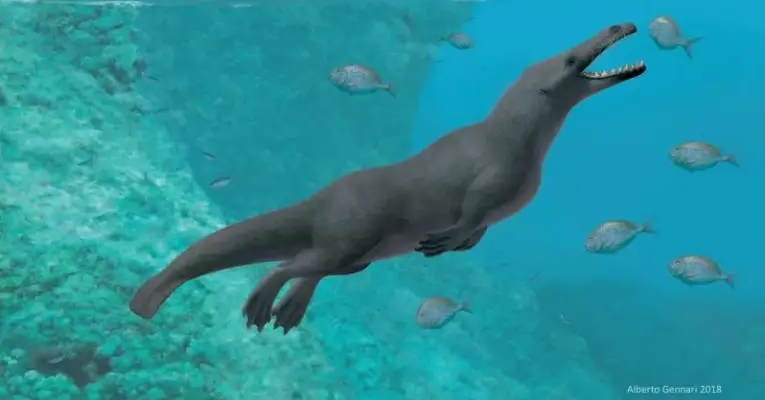Animals
Ancient Four-Legged Whale Uncovered in Peru Walked on Land, Swam in Sea

When we think of whales, it’s unlikely that such features as four legs, hooved toes, and webbed feet come to mind.
However, a fossil discovered in Peru has given researchers new insights into the earliest known whales and could change our understanding about how whale species spread across the globe, according to a study published Thursday in peer-reviewed journal Current Biology.
The ancient whale dates backed to about 42.6 million years ago and was capable of living both on land and underwater. Roughly 13 feet long, the mammal had hooves on the tips of both its fingers and toes, and is assumed to have had webbed appendages–meaning it was adapted to both a terrestrial and aquatic lifestyle.
Travis Park, a postdoctoral fellow with the Natural History Museum in London, noted:
“This partial skeleton represents a creature that could swim very well using its strong tail and webbed hands and feet, yet could still walk around on land on its hooved fingers and toes.”
Based on the bone structure of its tail vertebrae, the researchers believe the ancient whale moved in the water like an otter, which also has webbed toes.
Ancient four-legged whale from Peru walked on land, swam in sea https://t.co/ywkVO9QIJg pic.twitter.com/8dzJk7tKEo
— Reuters (@Reuters) April 4, 2019
Study author Olivier Lambert of the Royal Belgian Institute of Natural Scientists commented:
“This is the first indisputable record of a quadrupedal whale skeleton for the whole Pacific Ocean, probably the oldest for the Americas and the most complete outside India and Pakistan.”
The study noted that cetaceans–the order of aquatic mammals that includes species of whales, dolphins, and porpoises–evolved around 50 million years ago from hoofed, four-legged mammals who lived in South Asia.
From there, they traveled toward northern Africa and eventually to North America, but gaps in fossil records make it difficult to recount exactly how and when they reached the hemisphere.
However, the latest discovery has convinced scientists that the species likely reached South America after crossing the southern Atlantic from western Africa. At that point in Earth’s history, the distance between the continents was far shorter, supporting the new theory.
Lambert told Reuters:
“We think that it was feeding in the water, and that its underwater locomotion was easier than that on land.”
Park added:
“The evolution of whales is perhaps the best-documented example of macroevolution that we have, with the group going from small, dog-sized, hoofed mammals to the giants of the ocean we know and love today.
However, despite having a good fossil record of the different stages involved, there are still questions remaining as to the routes that early whales took when they first spread around the world.”
The fossil was discovered by an international team of paleontologists who located the ancient whale in 2011 in the coastal desert plains of southern Peru–a region long known for its rich deposits of ancient marine fossils. The whale has since been named Peregocetus pacificus, which means “the traveling whale that reached the Pacific.”
The team plans to continue digging in Peru for more fossils of ancient whales and dolphins in an area where many other whales dating back as far as 36.4 million years ago have been found.
Typos, corrections and/or news tips? Email us at Contact@TheMindUnleashed.com
